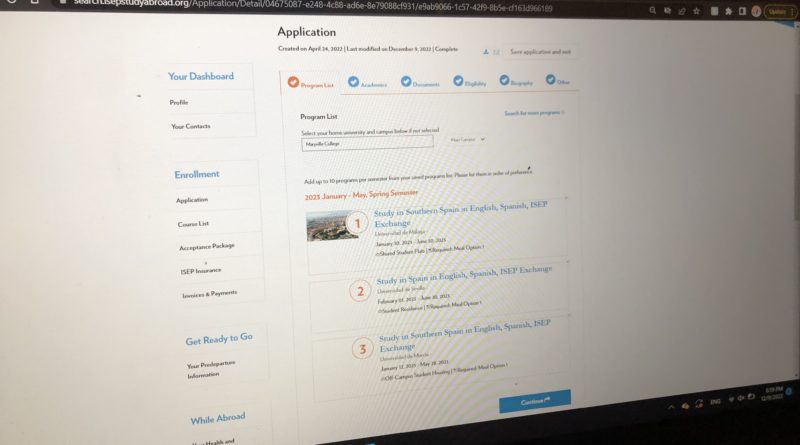Emily Goes to Spain: A Guide to Studying Abroad
This spring, I’ll be studying abroad at the Universidad de Málaga in Southern Spain. If you’re a Spanish major like me, you’ll also be required to spend a semester in a Spanish-speaking country. But any Maryville College student can study abroad at no additional cost. I have friends who will be studying in Ireland and the Netherlands, for example.
I’m starting this column to share my study abroad experience with you. I don’t depart until late January (the Spanish spring semester starts a bit later than ours does), but I thought I could talk about how I’ve been preparing.
The first thing I did was meet with my advisor. He helped me work out a four-year plan that allowed me to leave Maryville College for a semester. Since I’m a Spanish major, I’m required to take at least 12 credit hours on language and culture, entirely in Spanish.
If you’re not a Spanish major, you might have a little more wiggle room. Oftentimes, you can find classes abroad that substitute for Core Curriculum or major/minor requirements. You can even secure an internship. So, don’t rule out studying abroad just because you have a tight four-year plan.
Once I worked things out with my advisor, I set up a meeting with the Center for Global Engagement to talk about study abroad opportunities. It’s important to get the ball rolling as soon as possible. Here’s a list of application deadlines, so you’re in the know:
May-term: October 3
Fall semester: November 15, a year in advance
Summer (study/intern/service-learning): January 16
Spring semester: April 15, a year in advance
An advisor at the Center for Global Engagement helped me select my three top-choice schools, as well as a couple of backups. We picked ones that offered a variety of classes that align with my educational goals. The Universidad de Málaga was my first choice because it offered a lot of art history and literature courses. The city of Málaga also happens to be big on sustainability (which is super important to me), and it’s the birthplace of Picasso.
Then, it was time to apply. Some programs require you to apply directly to the school, but I applied for all of mine through the International Student Exchange Program (ISEP). It was nice because I only had to complete one application for all three of the programs I ended up applying for (you can apply for as many as 10, by the way).
The application process was pretty painless. I had to upload my transcript and request a faculty recommendation, and I had to ask my Spanish professor to score my Spanish language proficiency.
I also had to complete an application through the Maryville College website, but the process looks a bit different now. The school now uses a travel management software called Via TRM. Before applying through ISEP, you can use the software to choose your program and get approval from Maryville College.
I have since transitioned to using Via TRM for other study abroad preparations, and I’m quite the fan. It has all the forms I need to fill out in one place, and it sends me reminders when it’s time to submit them. The fact that it uses Single Sign-On is also really nice, since I tend to forget my passwords.
While I waited to hear back from ISEP, I applied for my passport and got my Real ID at the DMV. On May 3, 2023, U.S. travelers must be REAL ID compliant to board flights.
I also enrolled in OVS 203, which is a required study abroad prep course. We meet for a couple hours, once a week. It’s nice having a little community of people who will be studying abroad at the same time as me. We made a groupchat to stay in touch while we’re abroad.
In September, I received my ISEP placement. I had one more form to fill out for the Universidad de Málaga, and then I was accepted at my top-choice school! I got really lucky because it’s one of the more competitive schools to get into.
Now, I’m waiting for the final pieces to fall into place. Some countries, including Spain, require you to acquire a VISA to study there. I applied a couple months ago, and I’m waiting to hear back. It can take several months, so it’s better to apply sooner rather than later.
I’m currently searching for an apartment. Some schools have on-campus housing and meals, while others give you a stipend to cover the cost yourself. You shouldn’t have to pay anything out-of-pocket, unless you go for something really extravagant.
While the cost of tuition is the same, there are still some additional costs associated with studying abroad. I’ve listed some of my bigger ones, so you can plan accordingly:
ISEP application fee: $100
ISEP acceptance fee: $425.00
Insurance fee: $600 ($100 per month)
Plane ticket: estimated $1,500
Luggage: $73
Total: $2,698
I’m covering the school-related costs through scholarships. I highly recommend applying for Maryville College’s scholarships. Your only competition will be the handful of students studying abroad at the same time as you, and that’s if they take the initiative to apply.
You’ll also probably want some extra money in the bank for any cool experiences that might come up. I know I really want to check out all the art museums and some of the traditional festivals. If I can swing it, I’d also like to go on some weekend trips to neighboring countries.
Since I have a month-long gap between the end of fall semester and the beginning of spring semester, I’ll be working at my part-time job full-time. I also have a number of side hustles, like Spanish tutoring and farm-sitting.
I’ve got a little over a month left before I depart, and I can’t wait to tell you how it goes. Stay tuned for another installment of this column. I’ll tell you the nitty gritty details.

